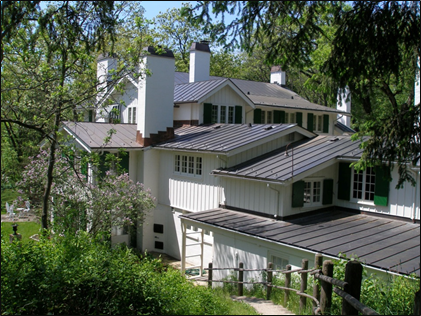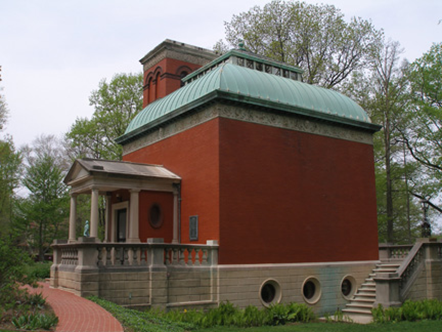Last updated: June 25, 2018
Article
Promoting Your National Historic Landmark
This year (2010) the National Historic Landmark (NHL) Program held a meeting that included all of the regional offices at the Colorado Chautauqua NHL in Boulder, Colorado. We were all struck by how the NHL designation is a prominent component in the Colorado Chautauqua Association‘s promotion of the site. In retrospect it occurred to us that many owners/stewards of NHLs do not utilize the significance of their designation in the promotion of their site or community. In these economically stringent times, it is important to consider all available possibilities to find funding for preservation efforts.
Consider the following questions:
Consider the following questions:
Do you identify your property as an NHL on public signage?
Do you prominently display the NHL plaque?
Do you mention the NHL designation when you apply for grants?
Do your programs involve the public on a local, regional, and national level?
Have you developed a website that promotes your programs?
Have you developed a strategic plan?
Do you interact with area universities to establish internships?
Do you call on your NPS contact person for technical advice and guidance?
Do you prominently display the NHL plaque?
Do you mention the NHL designation when you apply for grants?
Do your programs involve the public on a local, regional, and national level?
Have you developed a website that promotes your programs?
Have you developed a strategic plan?
Do you interact with area universities to establish internships?
Do you call on your NPS contact person for technical advice and guidance?
In the National Park Service (NPS) Midwest Region, a number of NHL property owners have creativley developed programs and actively sought grants to support their properties. Two examples of successful NHLs in our region include Ten Chimneys NHL in Genesee, Wisconsin, and the General Lew Wallace Study NHL in Crawfordsville, Indiana.
Ten Chimneys was designated an NHL on July 31, 2003. It is nationally significant in the area of performing arts for its association with Alfred Lunt and Lynn Fontanne. From 1922 until their deaths in 1977 and 1983, the property was the primary residence for Lunt and Fontanne and a social and cultural center of the American theater. Throughout their careers as the "first family" of the American theater, during which they starred together in 35 Broadway plays, the home served as a creative hearth including Noel Coward, Helen Hayes, Laurence Olivier, and Vivien Leigh. Plays were written, reworked, and honed on the estate during the summer months, before the couple returned to Broadway for the theater season. Ten Chimneys consists of the main house, a cottage, a studio, and a number of ancillary structures, such as the swimming pool, bath house, and agricultural buildings.
The General Lew Wallace Study was designated an NHL on May 11, 1976. General Wallace designed the structure himself, and it is reflective of his boyhood dreams, vivid imagination, and impressions gathered from a lifetime of reading and travel. The eclectic structure is a blend of Romanesque, Byzantine, and Periclean Greek architecture. Now a museum that displays artifacts chronicling every aspect of his varied life, the study contains the original white oak bookcases on three of the four walls. The frosted and stained glass skylight is intact and diffuses natural light into the main room. Although Wallace is best remembered for his authorship of Ben Hur in 1880, he was also a nationally significant person in the military, political, and diplomatic fields in the history of the United States.
The stewards of both of these NHLs have actively pursued and been successful in receiving grants for restoration projects at their sites. What follows are the stewards‘ descriptions of programs and strategies used in the management of these NHLs.
The stewards of both of these NHLs have actively pursued and been successful in receiving grants for restoration projects at their sites. What follows are the stewards‘ descriptions of programs and strategies used in the management of these NHLs.

National Park Service
Ten Chimneys
When both the humblest corncrib and the grandest drawing room are contributing factors to our NHL status, one is obligated to have a holistic approach to preserving and sharing Ten Chimneys. In addition to Estate Tours (and free exhibitions), Ten Chimneys Foundation offers Music in the Drawing Room, Play Readings at Ten Chimneys, and Conversations at Ten Chimneys. The Lunt-Fontanne Fellowship Program is our largest and most visible program for American theatre.Well over 250 passionate and dedicated individuals proudly call themselves Ten Chimneys Volunteers. In 2009 alone, volunteers have donated over 10,000 hours of work — preserving the estate, caring for the grounds and gardens, guiding guests through the Ten Chimneys Experience, and many other activities. Ten Chimneys Foundation is deeply committed to striking the balance between preservation and access. We have always felt that guests should experience Ten Chimneys as if they were a guest of the Lunts in their home — no ropes, nothing behind glass. Volunteer docents complete 14 weeks of training prior to guiding tours at the site (Ten Chimneys 2009 Newsletter).
Being the stewards of an NHL encourages participation with local preservation efforts. The agriculture outbuildings have been the recent focus of University of Wisconsin preservation internships and expanded behind the scenes tour experiences. Fifteen graduate students from the University of Wisconsin-Milwaukee‘s Preservation Institute spent an entire week at Ten Chimneys with lectures on the lawn for the public and then spent days documenting the rambling Main House with measured drawings prepared to Historic American Buildings Survey (HABS) standards (Kevin McKay, Director of Historic Preservation, e-mail 7/1/2010).
Serving as "a continuing resource and powerful inspiration for theatre" is an important part of Ten Chimneys Foundation‘s mission. The Lunt-Fontanne Fellowship Program is a ground-breaking national program that serves regional-theatre actors and the future of American Theatre. Every year, 8-10 of the top regional theatre actors in the country, each nominated by one of America's premier nonprofit theatres, participate in an intensive weeklong retreat and master class at Ten Chimneys with a world-renowned master teacher. Each of the selected actors receive a cash fellowship along with paid travel and lodging expenses (Ten Chimneys Lunt-Fontanne Fellowship Program website).

National Park Service
General Lew Wallace Study & Museum
In these challenging economic times, it is increasingly important for cultural facilities to embrace new approaches for both secur-ing public awareness and seeking funding support. For facilities like the General Lew Wallace Study & Museum embracing new approaches has proven critical. The Lew Wallace Study NHL is located in Crawfordsville, Indiana, a community of 15,000. Crawfordsville is unusual because it has a number of excellent museums that are well respected by the community. However, it is one of the larger communities in a rural area that has seen its share of economic distress.As the community has suffered over the last two years, cultural facilities that rely on community support have suffered because the limited resources that are available are split between these different museums.
In 2003, the Lew Wallace Study and Museum began an aggressive redevelopment of its operations. This redevelopment included a redrafting of its mission statement to give the museum a broader appeal and increased relevance. The Study & Museum also began to incorporate new technologies into its marketing, public outreach, and funding research. These technologies included early entry into Facebook, blogging, Twitter, YouTube, MySpace, Flickr. These efforts provided relatively inexpensive ways to reach out to communities beyond Crawfordsville.
Although we are careful to keep the local community well apprised of our activities and successes, by reaching those beyond Crawfordsville we are able to expand membership support, keep in better contact with those who have an interest in Wallace, cultivate donor prospects easily and effectively, and gain access to significant granting sources and funding opportunities.
As we have sought increased support from beyond the community, we have also been working to develop programming that addresses local needs, such as the Lew Wallace Youth Academy, developed Taste of Montgomery County—a major fund raising event that highlights the community, and we have created an endowment that will, hopefully, over the years provide a more stable source of income so that we are not solely dependent on grants and solicitations. This plan for a diversified income stream will help us maintain our operations so that we are not solely dependent on one income source and will also encourage flexibility so that we can move quickly to shift resources to seize opportunities that become available (Larry Paarlberg e-mail 7/6/2010).
On October 7, 2008, the General Lew Wallace Study and Museum received the 2008 National Medal for Museum Service at a special ceremony hosted by First Lady Laura Bush. The National Medal, the nation's highest honor for museums that make their communities better places to live, is awarded to five out of 17,500 museums nationwide each year.
A recent successful grant application will allow for the repair of the Study‘s copper roof.
Originally published in "Exceptional Places" Vol. 5, 2010, a newsletter of the Division of Cultural Resources, Midwest Region. Written by Michele Curran.
